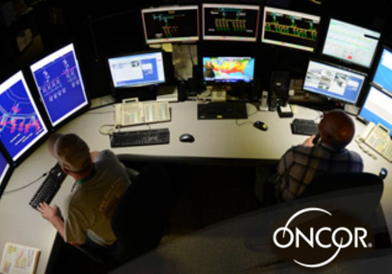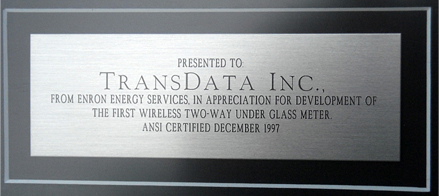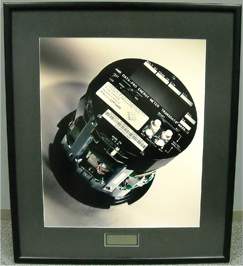© 2016 The Texas Lawbook.
By Jeff Bounds
(May 24) – Two trials in East Texas later this year will go a long way in determining whether a total of five separate patent infringement lawsuits from a small Dallas-area company will turn into billion-dollar problems for two of the largest makers of “smart” electric meters in the U.S.
Itron Inc. and Landis+Gyr could face combined exposure of more than $2.88 billion by way of the five separate cases from Carrollton’s TransData.
Of the five cases that Itron and Landis+Gyr must worry about, two set for trial in Tyler this year will probably influence the ultimate outcomes of the other three, according to Jamie McDole, a Dallas-based partner at Haynes and Boone who is leading TransData’s legal charge.

The first Tyler trial, set for July 18, will be in the courtroom of Magistrate Judge John D. Love.
District Judge Robert W. Schroeder III will preside at the second trial, which will kick off Sept. 19.
In the July case, Houston-based CenterPoint Energy Houston Electric will attempt to fend off accusations that it has used electric meters that supposedly infringe three of TransData’s patents. CenterPoint is receiving indemnification from Liberty Lake, Wash.-based Itron Inc. (Nasdaq: ITRI), which made the smart meters in question.
In the fall, three North Texas utilities will seek to fight off TransData’s patent-infringement contentions. Those three – Dallas-based Oncor Electric Delivery, Corinth’s CoServ, and Denton Municipal Electric – are also receiving indemnification from the meter makers whose products they use.
The U.S. business of Switzerland’s Landis+Gyr is indemnifying Oncor and CoServ. Denton Municipal is receiving indemnification from a small meter maker, Trilliant, and possibly others.
WHO IS ON TRIAL: Here is a look at the defendants that will be on trial this year against Carrollton’s TransData:
July 18:
CenterPoint Energy Houston Electric

- Headquarters: Houston
- Corporate parent: CenterPoint Energy Inc.
- Receiving indemnification from: Itron Inc.
Sept. 19:
Oncor Electric Delivery Co.

- Headquarters: Dallas
- Corporate parent: Energy Future Holdings Corp.
- An investor group led by Dallas-based Hunt Consolidated is in the process of buying Oncor
- Receiving indemnification from: Landis+Gyr
Denton County Electric Cooperative, (doing business as CoServ Electric)

- Headquarters: Corinth
- Receiving indemnification from: Landis+Gyr
Denton Municipal Electric
- Headquarters: Denton
- Receiving indemnification from: Trilliant, possibly others
Sources: Court filings, Texas Lawbook research
Depending on what happens with the July and September trials, it’s possible that Itron and Landis+Gyr could face separate infringement trials at later dates in Tyler, according to McDole.
In addition, TransData has an infringement lawsuit pending in San Diego against a California utility that uses Itron meters, San Diego Gas & Electric.
Like TransData’s direct suits against Itron and Landis+Gyr, the San Diego case has been put on hold while the two Tyler cases play out this year.
“One way or another, a significant amount of the issues should be resolved in July and September,” McDole said.
BIG PLAYERS: Here is a look at the two large makers of “smart” utility meters that face the biggest stakes from infringement litigation by Carrollton’s TransData:
Itron Inc. (Nasdaq: ITRI)

- Headquarters: Liberty Lake, Wash.
- Annual revenue: $1.9 billion (2014 fiscal year)
- Employees: 8,000 as of Dec. 31, 2014
- Indemnifying: CenterPoint Energy Houston Electric, San Diego Gas & Electric Co.
- Number of allegedly infringing meter: 35 million
- Possible exposure from TransData litigation: $1.83 billion
Landis+Gyr
- Headquarters: Switzerland (although Transdata’s suit is technically against Landis+Gyr’s U.S. operation.)
- Majority owner: Toshiba (Japan)
- Annual revenue: More than $1.5 billion (2014-15 fiscal year)
- Employees: 5,700 in 30 countries
- Indemnifying: Oncor Electric Delivery Co., Denton County Electric Cooperative (dba CoServ,)
- Number of allegedly infringing meter: 20 million
- Possible exposure from TransData litigation: $1.05 billion
Sources: Court filings, Texas Lawbook research
It’s “very uncommon” for small businesses to land royalties worth millions or billions of dollars on patents they control through litigation, according to Saurabh Vishnubhakat, an associate professor at Texas A&M University School of Law in Fort Worth.

Lending strength to TransData’s court battle with Itron and Landis+Gyr is that since 2011, it has successfully fended off 13 administrative challenges to its three patents through the U.S. Patent and Trademark Office.
Defendants like Itron and Landis+Gyr can use at trial the arguments on invalidity that got rejected by USPTO judges and examiners. But they will face an uphill climb in getting juries or judges to buy those arguments, since the USPTO has rejected them multiple times, McDole said.
“Based on TransData’s victories at the USPTO, it will be more difficult for the defendants to prove their cases at trial,” McDole said.
One of the lead attorneys for the defense, Lawrence Nodine of the Atlanta office of Ballard Spahr, declined comment.
What Separates TransData’s Case
At first blush, the odds appear stacked against TransData.
In addition to the greater resources they enjoy for funding court fights, large defendants like Itron and Landis+Gyr can also kill some or all of a small plaintiff’s patents through challenges at the USPTO.
“Administrative proceedings use a more lenient burden of proof and a more challenger-friendly standard for interpreting the patent, so it can be much easier to prove a patent invalid in the administrative setting,” Vishnubhakat said.
All told, a relatively small number of patent owners of any size even try to recover $1 billion or more through the courts, much less succeed, according to David Taylor, an assistant professor at the Dedman School of Law at Southern Methodist University in Dallas.

There are two reasons why TransData’s patent lawsuits present major issues for Itron and the U.S. operation of Switzerland’s Landis+Gyr, which is majority-owned by Japan’s Toshiba.
One is the sheer numbers involved. In court filings, TransData has estimated that 35 million meters from Itron infringe its patents, 20 million from Landis+Gyr.
Among the utilities and meter makers that have licensed TransData’s intellectual property, at least one of those licensing deals involved a running royalty payment of $17.50 for particular smart meters that use the company’s patented inventions, according to a company press release.
Those numbers suggest that if TransData wins its case, Itron could be looking at damages of $612.5 million, Landis+Gyr $350 million.
The numbers grow from there when factoring in TransData’s allegation that the infringement by Itron and Landis+Gyr was “willful,” or voluntary and intentional. If it wins on that score, the damages that Itron and Landis+Gyr face could be trebled.
In that scenario, Itron’s total damages could exceed $1.83 billion, while Landis+Gyr could be looking at a tab of $1.05 billion – or more than $2.88 billion combined.
So far, Landis+Gyr has refrained from public comments about what impact, if any, a large win for TransData might mean for its finances. Toshiba, Landis+Gyr’s corporate parent, brought in roughly $55.5 billion in revenue for its latest fiscal year ending in September 2015.
In quarterly financial filings, Itron has said it does not believe the TransData litigation “will have a material adverse effect on (its) business or financial condition.”
However, those filings say, “an unfavorable outcome could have a material adverse effect on (its) results operations for a period in which such a loss is recognized.”
Itron last year was the largest player among smart meter makers in the United States, controlling about 23.3 percent of the then-$1.8 billion market for the devices in this country, according to a June 2015 report from IBISWorld, a Los Angeles market research firm.

MARKET SNAPSHOT: Here is a look at the American market for manufacturers of smart utility meters. All numbers are from June 2015.
What they are: Smart meters enable electric, water or gas utilities to have two-way communication with the devices, allowing the utilities to monitor customer in real time. (TransData’s patents cover only electric smart meters.)
Benefits – Smart meters permit utilities to:
- Remotely connect and disconnect power;
- Detect outages;
- Resolve other power-delivery issues.
Size and growth:
- Revenue: $1.8 billion
- Profit: $168.3 million
- Electric meter market share: 75.4 percent
- Annual growth, 2010-15: 11.3 percent
- Annual growth, 2015-2020: 16.9 percent
- Businesses: 57
Expansion forecast – Between 2015 and 2020::
- Industry players: Will grow an average 8.8 percent annually, to 87
- Employment: Increase at an annualized 14.4 percent, to 6,978
- Sales: $3.9 billion by 2020
“Smart meter manufacturing in the U.S.,” IBISWorld Industry Report, June 2015
Electric meters, which the TransData patents cover, accounted for roughly 75.4 percent of the U.S. market at the time, the IBISWorld report said. Gas meters made up 15.6 percent, and water 9 percent.
The report lumped Landis+Gyr among a group of roughly 55 businesses that cumulatively account for nearly 59 percent of the U.S. market.
IBISWorld’s study did not detail Landis+Gyr’s market share, but listed it among players that “play a prominent role in the number of smart meters installed” and “generate strong sales throughout the country.”
Successful Push So Far
Every day, of course, plaintiffs nationwide bring litigation of all types with big theoretical damages at stake, only to see their cases turn into small potatoes in the end.
What separates TransData from other plaintiffs is the tremendous success it has seen from its enforcement push on its patent rights.
Since October 2010, the company has filed a total of nine separate infringement cases in far-flung locales like Alabama, Georgia, Mississippi, Oklahoma and Wisconsin.
Those suits helped result in the company inking licensing pacts with 14 utilities and meter makers, including large players like General Electric. GE in 2015 was the No. 2 player in the U.S. among smart meter makers, with 17.9 percent of the U.S. market in 2015, according to IBISWorld.
Along the way, defendants in the various court cases banded together to challenge the validity of TransData’s patents in litigation.
Partly as a result, TransData wound up facing 13 administrative challenges to its three patents through the USPTO. Those challenges were all brought between 2011 and 2014 – some brought anonymously.
When the dust settled on the 13 challenges to the three patents, USPTO judges and examiners upheld each of the patent claims that TransData had asserted the defendants had infringed, McDole said. Claims are the elements of an invention that a patent owner can exclude others from using in their products without authorization.
In 10 of the challenges, USPTO examiners made a decision on the merits of the outside parties’ claims – and re-confirmed that TransData’s patents are valid.
In the other three challenges, the USPTO rejected invalidity claims from General Electric on procedural grounds.
Although the USPTO judges and examiners did not toss out any claims on TransData patents, the company voluntarily cancelled some claims on one patent that weren’t part of the dispute with the defendants, McDole said. But, he continued, TransData also added 22 new claims to that same patent by way of the USPTO proceedings.

“I describe it as almost like fighting with one hand tied behind your back,” he said.
Whispering In a Rock Concert
The roots of the patent squabble date to the late 1990s, when TransData engineers solved a key problem then affecting all mobile wireless electronics.
At the time, the State of California was in the process of deregulating its utility market. Enron Corp., the Houston energy-trading giant, wanted to get into the Golden State’s utilities field, but wanted to do so from Texas.
That meant Enron would need wireless meters so that it could monitor customers’ power usage without sending personnel into the field to read the devices. Trouble was, wireless electronics at the time required external antennas, which were easily damaged by inclement weather, animals and the like.
The reason antennas had to sit on the outside of electronics was that they would receive too much interference if they were placed inside a device like a power meter. McDole compares the technical challenge to carrying on a whispering conversation next to a speaker at a rock concert.
Enron went to a number of companies, including TransData, for help. But TransData was the only one that solved the problem, McDole said.
Enron announced plans in 1997 to roll out meters in California that used TransData’s technology. It even gave its small partner an award for its invention.

Although TransData acquired three patents on its technology in the early 2000s, Enron’s collapse wound up killing the small firm’s business opportunity in California.
Enron’s demise forced TransData to sell its manufacturing plant in Tyler, where founder Edward “Eddie” Gleibs had moved the business in 1987. Gleibs started TransData in Ohio in 1969, and wound up shifting the headquarters to Dallas-Fort Worth in 1991.
Although losing the Enron business was a challenge, TransData would face an even greater issue a few years later, McDole said.
Green Initiative Leads to Near Death Experience
Starting around 2005, the federal government began providing grants and other monetary incentives to combat greenhouse gas emissions. As part of that effort, it provided hundreds of millions of dollars to utilities to deploy smart meters.
That, McDole says, is when large manufacturers began selling utility meters that used TransData’s inventions to avoid the need to put antennas on the exterior of the devices.
“As a small company, TransData encountered difficulty competing against its own technology,” McDole said. “They had to lay people off and make hard business decisions.”
The smart meter boom gained steam starting in 2009, when federal stimulus legislation allocated $3.4 billion for smart-grid modernization, including support for rolling out smart meters, according to IBISWorld.
The number of electric smart meters grew 81 percent between 2009 and 2011, according to Energy Information Administration data in the IBISWorld study.

In addition to making it fast and easy to replace meters when they break, keeping wireless antennas on the interior means meters can report, say, precisely which homes have lost power in a storm. Smart meters can also be shut off remotely.
A sign of just how valuable both power regulators and utility companies consider smart meters can be found in the fees utilities are allowed to charge consumers who opt out of using them, McDole said.
In Dallas, Oncor Electric – a defendant in the September trial for which Landis+Gyr is providing indemnity – bills residential customers between $26.69 and $31.38 monthly for using meters that are not wirelessly enabled, according to its website.
That is on top of a one-time fee that customers must pay to use alternative systems to smart meters. That fee is either $169 or $211, depending on the amount of electricity their service plan allows them to use in a month.
Multiplying that out by the average length of a smart meter’s useful life, 12 years, shows that Oncor charges consumers as much as $4,012.36 to $4,729.72 to use “dumb” meters over the course of the devices’ lives, McDole said.

Opting to use litigation about the patent infringement wasn’t easy for TransData, as it sometimes meant having to sue customers such as Oncor, McDole said.
But ultimately, Eddie Gleibs’ widow, Joan – who serves as TransData’s CEO – and son Trace, who is the company’s president, felt they had to go to court to keep the company going, McDole said. Eddie Gleibs passed away in 2012.

Although TransData was once much larger, it today generates seven-figures worth of annual revenue by creating and selling high-end meters that utilities have used in places like the Hoover Dam.
“The Gleibs family is tight-knit, and they still live in the Dallas-Fort Worth area” McDole said.
© 2016 The Texas Lawbook. Content of The Texas Lawbook is controlled and protected by specific licensing agreements with our subscribers and under federal copyright laws. Any distribution of this content without the consent of The Texas Lawbook is prohibited.
If you see any inaccuracy in any article in The Texas Lawbook, please contact us. Our goal is content that is 100% true and accurate. Thank you.
